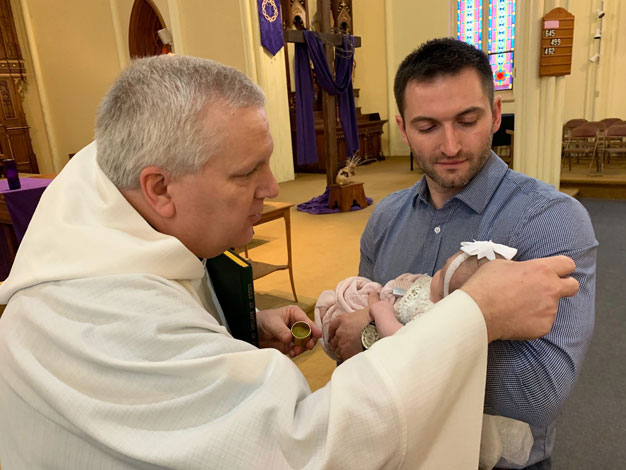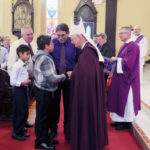
Father Marty Goetz baptizes Olive Vogel as her dad, Ben Vogel, holds her. She was baptized March 20 in Burlington.
By Deacon Frank Agnoli
For The Catholic Messenger
In 2019, Rome approved the English Translation of the 2nd edition of the Order of Baptism of Children (OBC) for use in the United States. We were able to start using it in the liturgy as of Feb. 2, the Feast of the Presentation of the Lord. Its use became mandatory Easter Sunday, April 12.
The church defines “children” as those who “have not yet reached the age of discretion” and so “cannot profess the faith for themselves” (OBC-Introduction, 1). While we usually use age 7 as the cutoff, it is important to note that this is a developmental criterion, not one based on age. Someone may well be above 7 years of age but still not have the ability to profess the faith for themselves.
The introductions stress the importance of baptism as the first sacrament, the “door to life” (Christian Initiation — General Introduction, 3) and to the other sacraments, by which we become part of Christ’s Body, the Church. Baptism is seen not as a private or family affair, but as a celebration, that involves the whole Church. The entire community is to be part of preparing catechumens for their full initiation, and in helping and supporting parents as they raise their children in the faith.
History
The Constitution on the Sacred Liturgy of Vatican II called for the revision of the liturgical texts and sacramental rites. The rite of infant baptism was the first one revised after the Council, even before the Missal. The first edition in Latin was promulgated in 1969 and the first English edition was approved later that same year. A Latin second edition was approved in 1973; but we would have to wait for decades to get updated translations.
In 2004, the U.S. bishops approved a Spanish translation of the rite (from the Mexican edition) for use in this country; in 2010 the use of that translation became mandatory. This year, we received the new English and a slightly updated Spanish second editions. Either of the two Spanish versions (2010, 2020), or the English version (2020), may be used.
Additions and changes
In addition to an updated translation, there have been a few other changes. The rite now provides the text for an optional introduction. In the past, the rite simply stated that the minister was to greet those present. The introduction may be used as written or adapted, or the minister may use his own words.
The words accompanying the Signing with the Cross are now “…the Church of God receives you with great joy…” instead of “…the Christian community…,” reflecting the change that Pope Benedict XVI made to the Latin edition in 2013. A simple acclamation has been added after each baptism. The Litany of the Saints may be expanded.
Previous U.S. adaptations also have been approved. Of note, the anointing with the Oil of Catechumens and the Ephphatha rite may be omitted, but the anointing with Chrism always takes place.
Of particular help to presiders will be the new Appendix, which lays out in detail how to celebrate baptism within Mass. In the previous edition, the instructions for doing so were found only in the introduction.
Catechetical opportunity
While the rite itself has not changed much, the advent of a new ritual book does offer us an opportunity to revisit how we prepare for, celebrate, and then live out the sacrament. Based on Pope Francis’ Joy of the Gospel, the Federation of Diocesan Liturgical Commissions offers parishes a series of questions to consider if we want to make our sacramental practice more evangelical.
Moments of Encounter
• What is the experience when a family first contacts the parish about baptism? Use three adjectives to describe it.
• Do we set reasonable conditions for who our parish will baptize? Are our policies designed for those already in our parish, or is there room for those who are seeking to enter?
• Do the times we offer for baptism meet the needs of families, many of whom are separated by distance or do not have local family help? Are these times sympathetic to the needs of infants and young children?
Formation of parents
• Do we believe that baptism is a start or a goal?
• Does our formation process allow flexibility for various family needs, including (but not limited to) baptizing older children, single-parent homes, challenging work schedules, or out-of-town preparation?
• Is our process of formation an educational process, or a journey of accompaniment? Is this how we wish to proceed?
• Is there value to having different processes for those who do or do not have a meaningful connection to the Church?
The celebration of baptism
• Does the baptism ritual seek to include all present in their respective ways, or is it enacted in such a way that only those “on the inside” are able to participate?
• Are all members of the assembly welcomed and enabled to participate?
The support of the parish community
• Would the new family say that they feel welcomed and supported by the faith community? What makes you arrive at this answer?
• What systems or connections do we have in place to accompany parents for the first 5 years of their child’s life, or until the child would formally begin religious education? Are these attentive to both the growth of the parent and the child?
• Does our faith community have connections to parents that don’t already belong to our parish?
• If not, how might we find them and make connections?
(Copyright Federation of Diocesan Liturgical Commissions. Adapted from an original by the Archdiocese of Cincinnati. Used with permission.)
Support The Catholic Messenger’s mission to inform, educate and inspire the faithful of the Diocese of Davenport – and beyond! Subscribe to the print and/or e-edition, or make a one-time donation, today!











